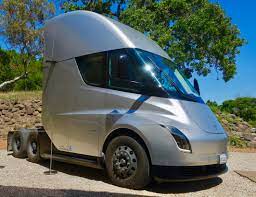Delivery of Tesla Semis to Pepsi Shifts EV Tech Into Fast Lane
With the first Tesla Semi trucks arriving at Pepsi plants in California starting in December, the road ahead for electric trucks will become much smoother, especially in the commercial vehicle sector.
Production of the Tesla Semi truck has gotten into gear. According to Elon Musk, Tesla’s chief executive officer, Pepsi plants in Sacramento and Modesto, California, will receive the first of these Class 8 electric vehicles beginning December 1. Pepsi will operate these EVs from its Sacramento beverage plant and its Modesto factory that handles Frito-Lay products.
The Tesla Semi truck. Image used courtesy of commons.wikimedia.org
Conceived in 2017, the Tesla Semi was initially slated for production in 2019. Supply chain difficulties delayed the Semi program, and until August 2022, production implementation was not expected to occur until 2023. However, in a surprise announcement in August, Musk confirmed that Semis would start to ship later in 2022. An announcement by the Tesla chief solidified the date as December 1 and the recipient as Pepsi.
Outperforming Diesel Mile for Mile
The Semi showcases competitive, and in several ways superior, advantages to conventional diesel Class 8 trucks. With its 500-mile range, the EV boasts a top highway speed of 100 mph and the ability to maintain a highway speed (65 mph) even while negotiating a 5 percent upward grade.
Energy use per mile totals less than 2 kilowatt-hours, or about half of its diesel counterpart. With an acceleration rate of 0 to 60 mph in 20 seconds carrying an 80,000-lb load (five seconds without a load), the Semi rivals the fossil-fueled truck, which takes 15 seconds to attain 60 mph without a load.
Efficiency, Savings are Evident
Cost savings from the Semi’s electric charging eclipses the diesel version, too. Compared with refueling a diesel Class 8 truck, electric charging is about 2.5 times cheaper. Tesla’s Semi Charger can recover about 70 percent of the truck’s range in 30 minutes. With power coming from three independent motors fitted to rear axles, there is only one gear—and no transmission. With no transmission for shifting gears, driver training would be streamlined.
EV diagnostics are performed remotely, and software is updated on the fly, so maintenance is dramatically reduced. Best of all, for the planet’s health, emissions are an obvious non-factor.
Drawbacks of the Semi
Yet, the Semi carries a payload of challenges. The biggest obstacle is the truck’s price tag–about $180,000 versus $88,293 for a diesel vehicle, according to a recent ACT Research report in Transport Topics. Outfitting an entire fleet with Semis would require an extreme long-term financial commitment. The vehicle cost could decrease as EVs become more prevalent in commercial trucking.
Semi batteries weigh about 1,300 pounds, three of which would cut into the maximum gross vehicle weight of 80,000 pounds, limiting cargo weight accordingly. These lithium-ion batteries take at least four hours to recharge fully, paring the truck’s potential time on the road and causing the driver’s hours-of-service schedule to depend on charging periods.
Semi’s Short-haul Transport Limitation
While it is a milestone as a distance achievement, the 500-mile range restricts the Semi to short hauls, with long hauls consisting of at least 600 miles. Interstate hauling, and even intrastate transport in some cases, generally would not be a viable option.
Front view of the Semi truck. Image used courtesy of commons.wikimedia.org
Since EV technology still is largely in its formative stages, resistance from older, established truck manufacturers and trucking fleets remains keen. This liability may succumb to time, especially when electric trucks become the norm. Besides Pepsi, the Semi already has orders waiting from firms, including Anheuser-Busch (40) and Walmart (130).
The inevitability of climate change will naturally make EV solutions more acceptable over time as rigid, anti-green attitudes change. The Semi likely will prove to be the leader of a convoy of progressively sophisticated EVs traveling the roads of the nation—and the world.
Updated as of December 7, 2022: Fulfilling its commitment, Tesla held a Semi Delivery Event at its Nevada-based Gigafactory in which PepsiCo took delivery of the first Semi off the production line. To demonstrate that the Semi actually has a range of 500 miles, Tesla recently recorded a trip in which a Semi carrying a full load covered the 500-mile trip from Fremont to San Diego, California.








